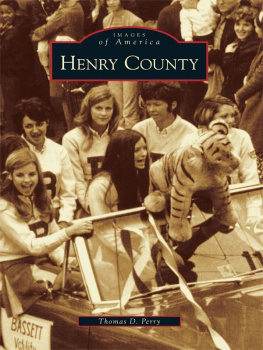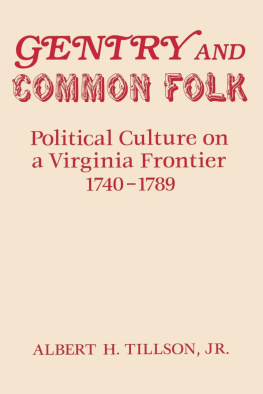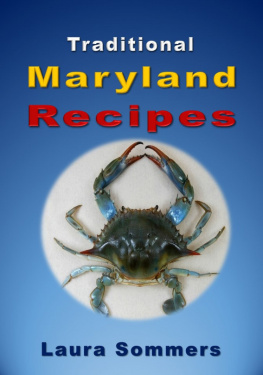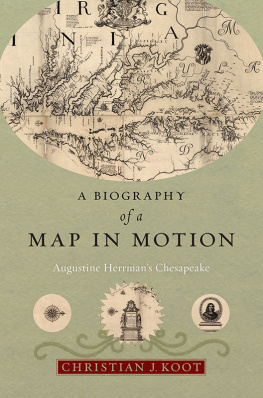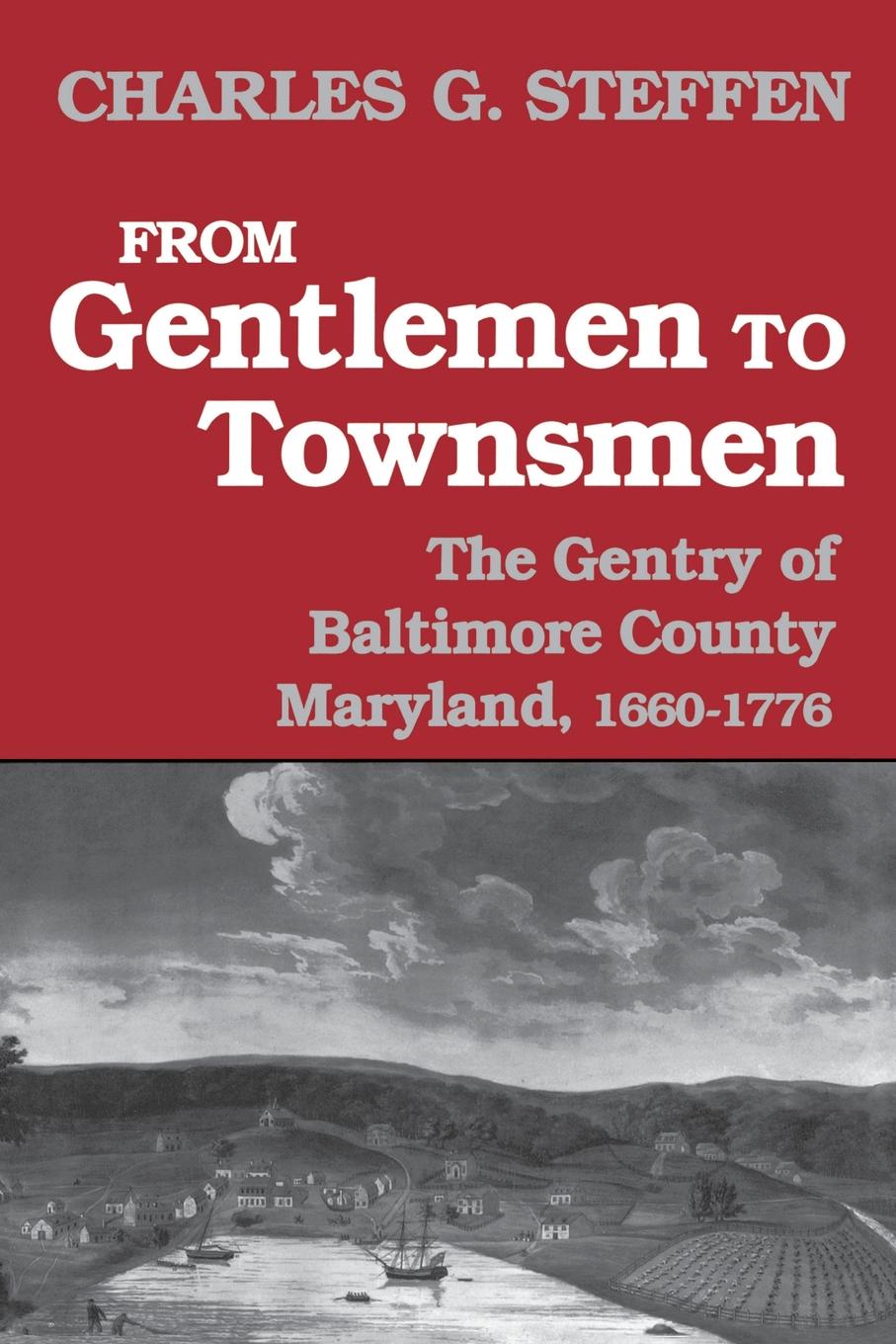From Gentlemen
to Townsmen
FROM
GENTLEMEN TO
TOWNSMEN
The Gentry of
Baltimore County,
Maryland
1660-1776
CHARLES G. STEFFEN

Copyright 1993 by the University Press of Kentucky
Scholarly publisher for the Commonwealth,
serving Bellarmine College, Berea College, Centre
College of Kentucky, Eastern Kentucky University,
The Filson Club, Georgetown College, Kentucky
Historical Society, Kentucky State University,
Morehead State University, Murray State University,
Northern Kentucky University, Transylvania University,
University of Kentucky, University of Louisville,
and Western Kentucky University.
Editorial and Sales Offices: Lexington, Kentucky 40508-4008
Library of Congress Cataloging-in-Publication Data
Steffen, Charles G., 1952
From gentlemen to townsmen: the gentry of Baltimore County,
Maryland, 16601776 / Charles G. Steffen.
p. cm.
Includes bibliographical references and index.
ISBN: 978-0-8131-5462-6
1. GentryMarylandBaltimore CountyHistory. 2. Baltimore
County (Md.)History. I. Title.
F187.B2S74 1993
975.2'71dc20 92-44321
This book is printed on recycled acid-free paper meeting the requirements of
the American National Standard
for Permanence of Paper for Printed Library Materials.

To Allyson and Brendan
Contents
List of Illustrations,
Maps, Figures, and Tables
Illustrations, Maps,
Figures, Tables
Illustrations
Maps
Figures
Tables
4. Distribution of Taxable Slaves in Baltimore County: 1692, 1737,
1773
11. Price of Rural Tracts Bought and Sold by Baltimore Elite:
1660-1776
15. Land Transactions of Elite Merchants and Elite Non-Merchants in
Baltimore County: 1660-1776
18. Members of Baltimore Elite with Decade of Death:
1660-1776
19. Merchants of Baltimore with Approximate Career Dates:
1660-1776
Acknowledgments
My thanks go to many people. The efficient, courteous, and knowledgeable staff of the Maryland State Archives made my visits to Annapolis pleasurable and profitable. I cannot imagine a better place to do historical research. The Committee on Institutional Studies and Research of Murray State University provided invaluable financial support for research and writing. Ken Wolf, Charlotte Beahan, Terry Streiter, Lois Green Carr, Jack Greene, and James Henretta made insightful comments on early versions of several chapters. I owe a special debt of gratitude to Joseph Cartwright, my former chairman and eternal friend, who struggled mightily to create a department in which scholarship was recognized and rewarded. The entire manuscript was read by Gregory Nobles, Richard Beeman, and Allan Kulikoff, whose probing questions opened my eyes to many things I had not seen before.
The dedication is to a pair of countervailing forces. Brendan did everything in the power of a determined three-year-old to prevent his father from finishing this book. Allyson did everything in the power of a devoted teacher, busy mother, and loyal compaera to see that it did get finished. Between the two of them, I have had the best of both worlds.
Introduction
During the past twenty years, a growing number of historians has been exploring and mapping the social terrain of the two colonies that encircle the Chesapeake Bay, Virginia and Maryland. It has been a truly collaborative enterprise, with each new insight simultaneously building upon and calling forth another. To name everyone who has helped revolutionize our understanding of the early Chesapeake would produce a long list and a weary reader.
But four contributors deserve to be named, because their sweeping interpretations have established the thematic framework and research agenda for those of us who write narrowly focused monographs about the small places and silent people of the Chesapeake. In numerous essays and his magnum opus, France and the Chesapeake, Jacob M. Price has traced the institutional maturation of the transatlantic tobacco economy. No single work has more poignantly captured the tragic interplay of race, class, and slavery in Virginia than Edmund S. Morgans American SlaveryAmerican Freedom. In The Transformation of Virginia, Rhys Isaac has offered a profound analysis of the structure and process of cultural hegemony among the tidewater gentry. Finally, the demographic and economic underpinnings of class formation in the Chesapeake have been the subject of Allan Kulikoffs masterful synthesis, Tobacco and Slaves.
Each of these historians, in turn, owes a tremendous debt to the formidable standards of methodological sophistication and empirical rigor set by the Maryland school. With single-minded determination, Lois Green Carr, Lorena S. Walsh, Russell R. Menard, David W. Jordan, and Paul G.E. Clemens have been draining every ounce of possible significance from probate, tax, and court records to reconstruct the economic and social conditions of early Maryland. Their quantitative approach to such questions as price movements, life expectancy, and mobility rates has reached a culmination in A Place in Time, Darrett B. Rutmans and Anita H. Rutmans richly researched book on Middlesex County, Virginia.
Yet in spite of this ambitious effort to illuminate every hidden feature and dark corner of Chesapeake life, from the great house and sleeping chambers to the slave quarters and family parlor, one group has not emerged from the shadows. This group, which I have called the county gentry, is the subject of the present study.
The claim that the gentry has somehow eluded scholarly scrutiny should raise more than a few eyebrows. After all, if one group has been privileged by historians of the colonial South, it is the class of privilege. Many outstanding studies of the gentry spring to mind: Jack P. Greenes meditations on the political culture of the Virginia gentry, Richard R. Beemans and Albert H. Tillson, Jr.s examinations of the transplantation of gentry culture to the Virginia backcountry, Aubrey C. Lands exploration of the multifaceted investments that sustained upper-class fortunes, T.H. Breens decoding of the cultural meanings attached to the gentrys economic behavior, Kenneth A. Lockridges psychological profile of one of Virginias foremost gentlemen, David Hackett Fischers search for the Old World determinants and continuities of gentry life, and Daniel Blake Smiths and Jan Lewiss investigations into the inner dimensions of the gentry family. The list could go on to include older works such as Charles Sydnors analysis of the paradoxical blend of popular elitism that characterized gentry politics, Louis B. Wrights treatment of the considerable intellectual attainments of the provincial gentry, and Thomas J. Wertenbakers and Bernard Bailyns accounts of the consolidation of gentry rule in Restoration Virginia.
How then can it be said, given this richly textured and broadly conceived body of scholarship on upper-class life in the colonial Chesapeake, that historians have not given the gentry its fair due? The answer becomes clear when we look closely at the specific individuals and families whose experiences have formed the basis of the most widely accepted generalizations about the gentry as a whole. One need read only a few pages of the key studies on gentry life to find extended discussions of Thomas Jefferson and George Washington of Virginia, Charles Carroll of Carrollton and Daniel Dulany of Maryland, and such multitentacled clans as the Lees, Carters, Byrds, Burwells, Addisons, Bennetts, and Ludwells. If we look more closely still, we see two men crowding out all the rest: William Byrd of Westover and Landon Carter of Sabine Hall, who left behind a pair of unique diaries on which several generations of historians have lavished textual analysis of Talmudic precision. No two sources have so thoroughly shaped our notions of gentry life.



